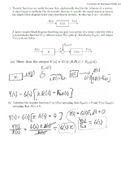Samenvatting Biology Campbell H4
Carbon: the basis of molecular diversity
Concept 4.1 Organic chemistry is key to the origin of life
Organic chemistry: the study of the compounds containing carbon, which are
called organic
In 1953, Stanley Miller set up a closed system to test with the conditions which
they thought were on the early Earth.
Concept 4.2 Carbon atoms can form diverse molecules by bonding to four other
atoms
Carbon has 6 electrons, 2 in the first electron shell and 4 in the second shell, so it
has 4 valence electrons in a shell that can hold up to 8 electrons. A carbon atom
usually completes its valence shell by sharing its 4 electrons. Each pair of shared
electrons constitutes a covalent bond.
Stanley Miller’s experiment Four ways that carbon skeletons can vary
, Valence: the number of electrons required to fill the valence shell/the number of
covalent bonds it can form
Hydrocarbons: organic molecules only
consisting of carbon and hydrogen.
Isomers: compounds that have the same
numbers of atoms of the same elements but
different structures and hence different
properties. Three types; structural isomers,
cis-trans isomers and enantiomers.
Structural isomers: differ in the covalent
arrangements of their atoms
Cis-trans isomers: carbons have covalent
bonds to the same atoms, but these atoms
differ in their spatial arrangements due to the
inflexibility of double bonds. The single bonds
allow the atoms they join to rotate freely
abound the bond axis without changing the
compound.
Enantiomers: isomers that are mirror images
of each other and that differ in shape due to
the presence of an asymmetric carbon.
Asymmetric carbon: one carbon which is attached to four different
atoms/groups.
Concept 4.3 A Few chemical groups are key to molecular function
Functional groups: a group of atoms in a molecule with distinctive chemical
properties, regardless of the other atoms in the molecule. The atoms in a
functional group are linked to each other and to the rest of the molecule by
covalent bonds.
The seven chemical groups most important in biological processes are the
hydroxyl, carbonyl, carboxyl, amino, sulfhydryl, phosphate, and methyl
groups.
Carbon: the basis of molecular diversity
Concept 4.1 Organic chemistry is key to the origin of life
Organic chemistry: the study of the compounds containing carbon, which are
called organic
In 1953, Stanley Miller set up a closed system to test with the conditions which
they thought were on the early Earth.
Concept 4.2 Carbon atoms can form diverse molecules by bonding to four other
atoms
Carbon has 6 electrons, 2 in the first electron shell and 4 in the second shell, so it
has 4 valence electrons in a shell that can hold up to 8 electrons. A carbon atom
usually completes its valence shell by sharing its 4 electrons. Each pair of shared
electrons constitutes a covalent bond.
Stanley Miller’s experiment Four ways that carbon skeletons can vary
, Valence: the number of electrons required to fill the valence shell/the number of
covalent bonds it can form
Hydrocarbons: organic molecules only
consisting of carbon and hydrogen.
Isomers: compounds that have the same
numbers of atoms of the same elements but
different structures and hence different
properties. Three types; structural isomers,
cis-trans isomers and enantiomers.
Structural isomers: differ in the covalent
arrangements of their atoms
Cis-trans isomers: carbons have covalent
bonds to the same atoms, but these atoms
differ in their spatial arrangements due to the
inflexibility of double bonds. The single bonds
allow the atoms they join to rotate freely
abound the bond axis without changing the
compound.
Enantiomers: isomers that are mirror images
of each other and that differ in shape due to
the presence of an asymmetric carbon.
Asymmetric carbon: one carbon which is attached to four different
atoms/groups.
Concept 4.3 A Few chemical groups are key to molecular function
Functional groups: a group of atoms in a molecule with distinctive chemical
properties, regardless of the other atoms in the molecule. The atoms in a
functional group are linked to each other and to the rest of the molecule by
covalent bonds.
The seven chemical groups most important in biological processes are the
hydroxyl, carbonyl, carboxyl, amino, sulfhydryl, phosphate, and methyl
groups.












